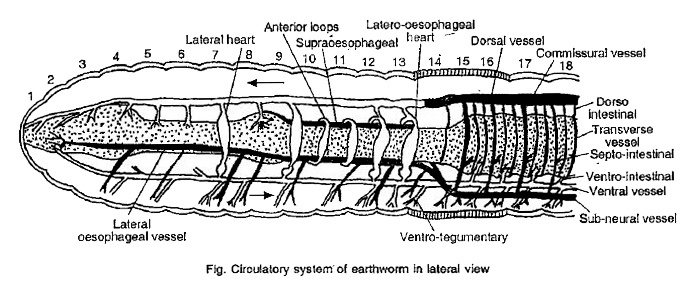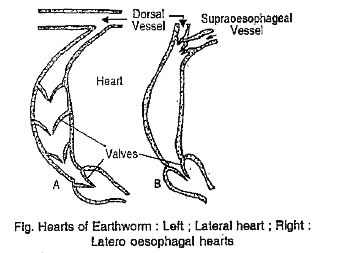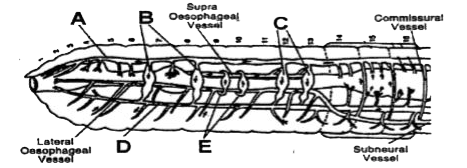Describe blood vascular system in earthwrom
Text Solution
Blood Vascular System. Blood vascular system of earthworm is closed type as the blood flows in the closed blood vessels. It can be studied as follows:
I. Blood. It is a mobile connective tissue composed of blood plasma and blood corpuscles. The plasma consists of water plus organic and inorganic substances. A coloured respiratory pigment, the haemoglobin (also called erythrocruorin) is present in the plasma. Due to the presence of haemoglobin the colour of the plasma is red. Only one type of blood corpuscles, the leucocytes, are present in the blood of earthworm.
2. Bloodvessels. Following are the prominent blood vessels found in earthworm : a dorsal, a ventral, a sub-neural, a pair of lateral oesophageal and a superaoesophageal.
(i) Dorsal blood vessel
Location. Dorsal blood vessel is the most prominent blood vessel which lies along the middorsal line between the alimentary canal and the body wall. It extends from one end of the body to the other. It has thick highly contractile muscular wall.
Flow of blood. The blood flows in this vessel from behind to forward by the rhythmic contractions (peristalsis).
Valves. The dorsal blood vessel has a pair of valves in its lumen in front of each septum.
Supply. It gives off a pair of small branches in each. of the 3rd, 4th, 5th, 6th and 8th segments where its branches supply blood to the pharyngeal nephridia pharynx, oesophagus and gizzard respectively.Anteriorly the dorsal vessel breaks up into fine branches which supply blood to the roof of the buccal cavity and the pharyngeal mass. The dorsal blood vessel also supplies blood to the ventral blood vessel through four pairs of hearts.
Collection. The dorsal blood collects blood behind 13th segments through dorso-intestinal and commissural vessels. The dorsointestinal vessels collect blood from the gut through transverse vessels that surround the gut.
In each segment the dorsal blood vessel receives two pairs of dorso-intestinal vessels from the intestine and stomach (in 14th segment only). It also receives a pair of commissural vessels from the sub-neural vessel after running through each septum from 14th/15th septum to the last septum.
Thus the dorsal blood vessel is a collecting blood vessel from 14th to the last segment while it is a distributing blood vessel in the first thirteen segments.
(ii) Ventral blood vessel location. It also extends from one end to the other end of the body. It lies along the mid-ventral line in between the alimentary canal and the ventral nerve cord.
Valves. It does not have any valve and flow of the blood is from the anterior to the posterior end of the body.

Supply. It is a main distributing blood vessel. It gives off a pair of ventro-tegumentary vessels in each segment which distribute blood to the body wall and the integumentary nephridia of that segment. A septo-nephridial branch given off from each ventro-tegumentary supplies blood to the septum and septal nephridia. Behind the 13th segment it gives off a single ventrointestinal vessel in each segment. The ventro-intestinal branch supplies blood to the intestine.
(iii) Sub-neural blood vessel. It lies along the mid-ventral line of the body wall below the ventral nerve cord. It runs from the posterior end of the body upto the fourteenth segment in front.
It also collects blood from the body wall through a pair of blood vessel through paired commissural vessels in each ·septum. Each commissural vessel gives off a septointestinal vessel to supply blood to the intestine.
(iv) Lateral oesophageal blood vessels. It is a pair of vessels lying one on either side of the alimentary canal between the body wall and the alimentary canal in the first fourteen segments. Both the lateral oesophageal vessels unite to form the sub-neural vessel in the 14th segment.Collection of Blood. The lateral oesophageal vessels collect blood from the buccal cavity, pharynx, oesophagus and the body wall and carry this blood to the supra-oesophageal vessel by two pairs of anterior loops situated in the 10th and 11th egments.
(v) Supra-oesophageal blood vessel. It is a single vessel which lies on the dorsal side of alimentary canal between the 9 and 13 segments, It receives blood from the lateral oesophageals through two pairs of anterior loops situated in the 10th and 11th segments and pour into two pairs of latero-oesophageal hearts present in the 12th and the 13th segments. Latero,oesophageal hearts pour their blood into the ventral blood vessel. The supraoesophageal vessel also collects blood from the gizzard and the stomach. In ten to fourteen segments there are present ring vessels in the muscular coats of the wall of the stomach. These are transverse vessels which are about twelve pairs per segment and join the supra-oesophageal above and the lateral oesophageal vessels below and carry blood from lateral oesophageals to the supra oesophageal-vessel.
3. Intestinal Blood Plexuses. There is present a pair of network of capillaries and blood vessels known as intestinal blood plexuses in the walls of the intestine and transfer the same to the dorsal blood vessel through the dorso-intestinal vessels. Internal intestinal blood plexus also receives blood from the external intestinal blood plexus.
4. Hearts and Anierior loops. In earthworm, there are present four pair of tubular hearts. These hearts are enlarged, thick walled pulsatile and provided with valves. The anterior two pairs of hearts, known as lateral hearts lie in the 7th and 9th segments and connect the dorsal blood vessel with ventral blood vessel. They receive blood.from the dorsal vessel and convey it to the ventral vessel. Each lateral heart bears four pairs of valves. The posterior two pairs of hearts are called laterooesophageal hearts and are situated in the 12th and 13th segments. The latero-oesophageal hearts apart from connecting the dorsal and ventral blood vessels are also joined with the supra oesophageal blood vessel. They have three pairs of valves to prevent the backward flow of the blood.Latero-oesophageal hearts carry blood from the dorsal vessel and the supra oesophageal vessel to the ventral blood vessel.

There are present two pairs of loop like vessels, the anterior loops in the 10th and 11th segments. These vessels connect the supraoesophageal vessel to the lateral-oesophageal vessels. They have no valves and their walls are non,muscular and hence non-pulsatile in nature, They carry blood from the lateral oesophageal vessels to the supra-oesophageal vessel.
|
Similar Questions
Knowledge Check
Blood vascular system of earthworm is of
AOpen typeBClosed typeCPortal typeDNone of theseBlood vascular system of earthworm is of
Aopen typeBclosed typeCportal typeDnone of theseBlood vascular system of earthworm is of
Aopen typeBclosed typeCportal typeDnone of the these.
Go through the blood vascular system of earthworm given in the following diagram


View SolutionBlood vascular system in hemichordata is
View SolutionClosed blood vascular system found in
View SolutionWhich of the following is correct about the blood vascular system of earthworm?
View SolutionBlood vascular system in hmichordata is
View Solution

